
Canned meat products have a certain appeal.
First is the morbid fascination of examining the ingredients, which might include items such as partially defatted cooked beef fatty tissue, beef tripe, or pork brains.
Then there's the pity on the photographer who was tasked with taking pictures for the label in an attempt to make the product look edible, if not delicious.
Finally, there's the speculation of what the product really looks like if you dare open the can.

Unlike products such as Pork Tidbits, where you can see the "tidbits" floating in yellow water, the can conceals the contents, providing a wonderful aura of mystery.
Choice is good
An educated consumer reads ingredients. Armour's Potted Meat Food Product was probably America's #1 choice because it contained not one, but two types of partially defatted cooked fatty tissues along with many other ingredients.
On the other hand, people may prefer Hormel's version because it has fewer ingredients and does not contain sodium erythorbate (unless that's in the meat broth). Both, of course, have mechanically separated chicken. Alternatively, there's always Libby's version of the product.
You take the taste test and let me know...
At some point, Armour stopped labeling it as "America's #1 Choice" and changed it to "America's Favorite." Is that a step up for the brand?
What's inside?
Ingredients changed over the years. For instance, with Armour's product, I observed the following evolution:
Version n:
Beef tripe, beef hearts, chicken, partially defatted cooked pork fatty tissue, water, salt, mustard, vinegar, dried garlic, sodium erythorbate, natural flavoring, sodium nitrite
Version n+1:
Chicken, Beef Tripe, Partially Defatted Cooked Pork Fatty Tissue, Beef Hearts, Partially Defatted Cooked Beef Fatty Tissue, Water, Salt, 2 percent or less: Natural Flavorings, Vinegar, Dextrose, Sodium Erythorbate, Sodium Nitrite
Version n+2:
Mechanically Separated Chicken, Beef Tripe, Partially Defatted Cooked Beef Fatty Tissue, Beef Hearts, Water, Partially Defatted Cooked Pork Fatty Tissue, Salt. Less than 2 percent: Mustard, Natural Flavorings, Dried Garlic, Dextrose, Sodium Erythorbate, Sodium Nitrite
Mechanically separated chicken
One question that has been plaguing me was, just what is mechanically separated chicken? I found the answer in the U.S. Department of Agriculture's Food Safety and Inspection Service's page on Meat and Poultry Labeling Terms:
Mechanically separated poultry is a paste-like and batter-like poultry product produced by forcing bones with attached edible tissue through a sieve or similar device under high pressure to separate bone from the edible tissue. Mechanically separated poultry has been used in poultry products since 1969. In 1995, a final rule on mechanically separated poultry said it would be used without restrictions. However, it must be labeled as "mechanically separated chicken or mechanically separated turkey" (depending on the kind of poultry used) in the ingredients statement. The final rule became effective November 4, 1996.
Meat by-products
Not exactly related to potted-meat, but going down the path of mechanical processing, one may wonder about the definition of meat by-products. The Flint River Ranch summarizes the definition as
ground, rendered, and cleaned slaughtered meat carcass parts such as necks, feet, undeveloped eggs, bones, heads, and intestines (and a small amount of feathers in the case of chicken
They cite the AAFCO definition:
Meat by-products is the non-rendered, clean parts, other than meat, derived from slaughtered mammals. It includes, but is not limited to, lungs, spleen, kidneys, brain, livers, blood, bone, partially defatted low temperature fatty tissue, and stomachs and intestines freed of their contents. It does not include hair, horns, teeth and hoofs. It shall be suitable for use in animal food. If it bears name descriptive of its kind, it must correspond thereto.
A Potted Meat Product Comparison

Armour Potted Meat Food Product
America;s #1 Choice
Ingredients: Mechanically Separated Chicken, Beef Tripe, Partially Defatted Cooked Beef Fatty Tissue, Beef Hearts, Water, Partially Defatted Cooked Pork Fatty Tissue, Salt. Less than 2 percent: Mustard, Natural Flavorings, Dried Garlic, Dextrose, Sodium Erythorbate, Sodium Nitrite
Hormel Potted Meat Food Product (Discontinued!)
Ingredients: Beef Tripe, Mechanically Separated Chicken, Beef Hearts, Partially Defatted Cooked Beef Fatty Tissue, Meat Broth, Vinegar, Salt, Flavoring, Sugar, Sodium Nitrite.
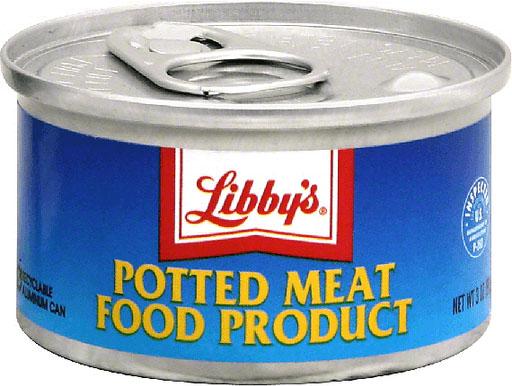
Libby's Potted Meat (Discontinued!)
Ingredients: Mechanically separated chicken, pork, water, salt, contains 2% or less of: mustard, vinegar, dextrose, sodium erythorbate, garlic powder, natural flavors, sodium nitrite.

Bryan - The Flavor of the South
Potted Meat: Made with Chicken, Beef, and Pork
Ingredients: Mechanically separated chicken, beef tripe, pork, no more than 2%: salt, vinegar, flavorings, dextrose, extracts of paprika, sodium nitrate
Is Armour Potted Meat Food Product America's #1 choice because the other brands are discontinued?
Some other meat products
For those who don't love the taste of potted meat, there are other canned meat options.

Pork Brains in Milk Gravy is irresistible for its cholesterol content alone (over 1100% of the U.S. RDA!). It's described as a "southern delicacy." Beware of "delicacies" anywhere in the world. Brains and egg seems to be the serving suggestion. Also note the U.S. flag and the "Made in the USA" underneath it. This shows the U.S. is still a manufacturing powerhouse.
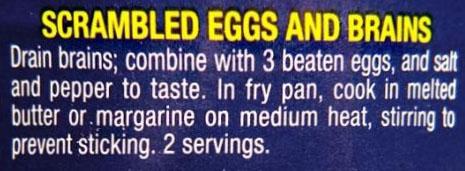
I'm not sure I can add any amount of salt and pepper to suit my taste but I bet there are lots of kids who enjoyed this for breakfast every bit as much as I enjoyed eating chocolate-frosted sugar bombs.
Luncheon meat is a term for processed meat product, typically made from ground pork and/or chicken, along with salt, spices, water, starch, and a preservative like sodium nitrite, to form a paste that is then cooked and canned or pressed into a block.
Spam is a brand of luncheon meat king of meat products for the sheer quality and purity of its ingredients.
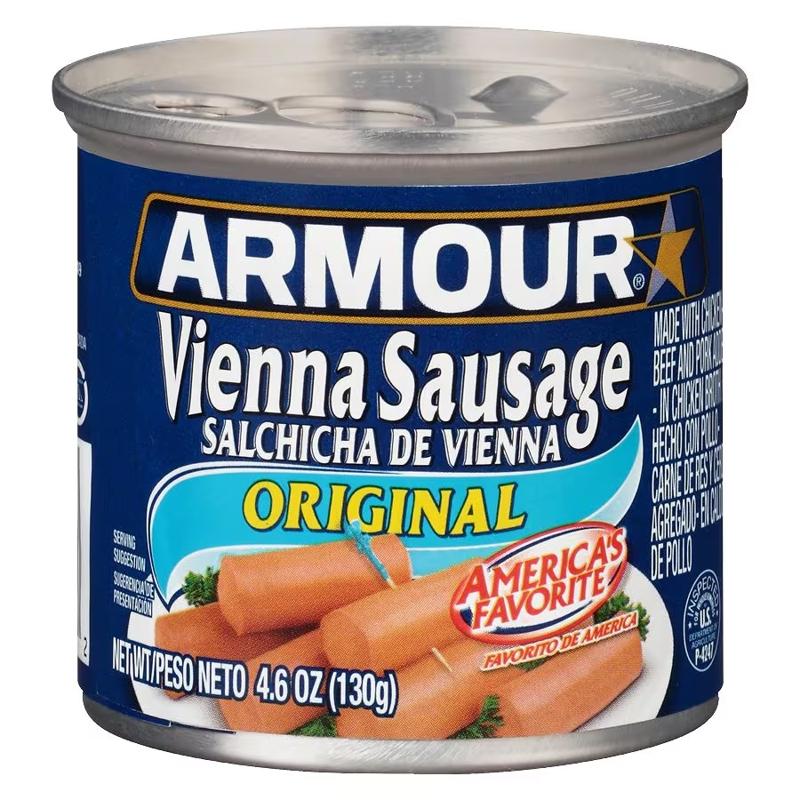
Vienna sausage: From the land of Wolfgang Amadeus Mozart, Franz Schubert, and Johann Strauss, we get essentially mini cold hot dogs in a can.
Ingredients: sausage: mechanically separated chicken, water, salt, corn syrup, contains 2% or less of: beef, pork, dextrose, natural flavors, sodium nitrite, garlic powder. broth: chicken broth.
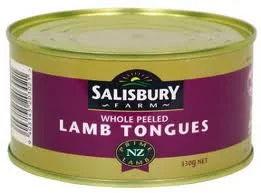
We reached a point in our civilization where we cut the tongues off baby sheep by the thousands, stuff them into cans, and ship them to customers eager to consume them. Lamb tongues probably look cute but seem to be unavailable in the U.S.. The tin in the picture is from New Zealand. Note that the Salisbury Farm product label points out whole peeled. Watch out for lesser brands, where the tongues may not peeled or may be truncated. Ingredients: Lamb tongues, mutton stock, salt, agar, potassium nitrate, potassium nitrite. Note the mutton stock. That's made from simmering the bones of mature sheep with water, vegetables, and seasonings. The baby sheep tongues are packed in bone broth made from grown-up sheep.
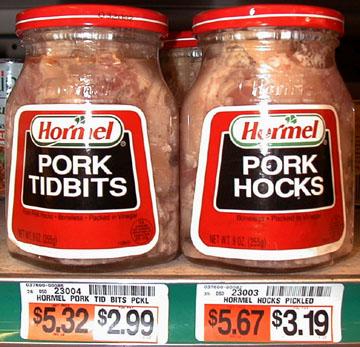 Pork Tidbits and Pork Hocks: pieces of pork swimming in some liquid. I don't know if these are still sold but this may be one reason why there's nostalgia for the 1990s. Was it worth paying $0.20 more for hocks?
Pork Tidbits and Pork Hocks: pieces of pork swimming in some liquid. I don't know if these are still sold but this may be one reason why there's nostalgia for the 1990s. Was it worth paying $0.20 more for hocks?
Get cultured
Slim Jim Brand Spicy Smoked "Snack" (notice they don't make any pretense to it being a meat snack) also contains mechanically separated chicken:
Ingredients: Beef, mechanically separated chicken, water, salt, corn syrup, dextrose, flavorings, spice, paprika, hydrolyzed corn gluten, soy and wheat gluten proteins, sodium nitrite, lactic acid starter culture.
This begs the question: what exactly is lactic acid starter culture? That's another topic for another day
Listed ingredients change over time; the ones listed are from the point of time when I observed them: